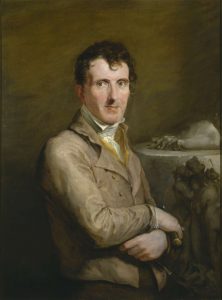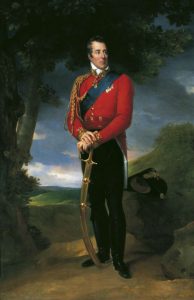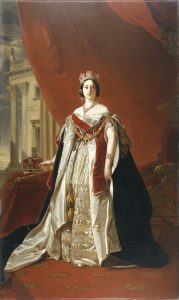Conversations with history
The art works from the Collection installed at the British Ambassador's Residence in Paris tell a story full of subtle references to history, recreating the backdrop against which diplomatic relations between the two countries began to unfold during the 19th century and beyond.
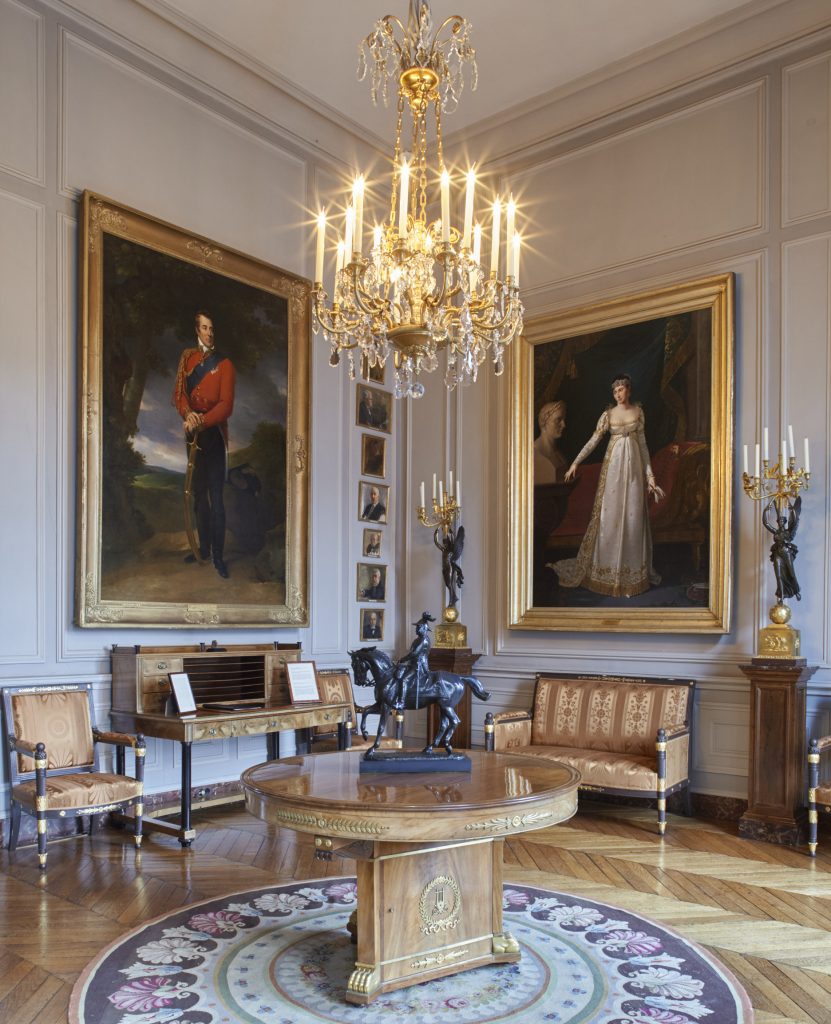
A portrait of the Duke of Wellington and Pauline Borghese, sister of Napoleon Bonaparte hanging in the Ante Room © Crown Copyright
The art installed at the Paris Residence is both contemporary and historical. While the displays stimulate dialogue amongst staff and visitors, doing the work of cultural diplomacy, the art works are also sometimes in conversation with each other, across time.
Portraits of royals and diplomats, as well as paintings showing significant events in Anglo-French history, have hung at the Paris Residence since the late 1930s. This painting by Heinrich Johann Lüttringhausen gives an insight into what the British Embassy gardens would have looked like in the 19th century. A visit to the British Residence in Paris in 1827 might have included a stroll through the garden in the company of Lady Harriet Granville, who was the wife of the Ambassador.
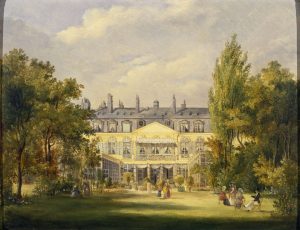
Johann Heinrich Luttringhausen, British Embassy in Paris from the Gardens, 1840 © image: Crown Copyright
You do not know how enjoyable it is at the moment. It is perfect retirement, and as fresh and fragrant as if it was fifty miles from a town. Roses and orange trees are all in bloom.
Lady Granville to Lady Carlisle, June 1827
Today, Shirazeh Houshiary’s sculpture Extended Shadow installed in those gardens, perhaps at almost the same spot that Luttringhausen stood to make preparatory sketches for his painting, is a contemporary punctuation mark in the history of this place, one that witnessed 19th-century costume balls, tea parties and a siege during the fall of the Commune.
Stand in the expansive gardens of the British Ambassador’s Residence in Paris below and look at the Glazed Galleries, and then imagine yourself on the inside, looking out.
In 1803, the British Ambassador’s Residence in Paris was the home of Princess Pauline Borghese, Napoleon I’s youngest sister. Admired by many for her classical beauty and unrivalled elegance, Pauline reshaped the interiors of her residence with strong-coloured fabrics and giltwood furniture, reflecting the sumptuous Empire style. She took up residence there with her new husband, Prince Camillo Borghese, who honoured Pauline with a commission from the Italian sculptor Antonio Canova.
Initially instructed to fashion her as the Roman goddess of war, Diana, Canova opted (or perhaps she instructed him) to show her as Venus Victorious. Canova’s original statue is in the Galleria Borghese in Rome but this small-scale copy of Canova’s original, in the Collection, is placed by our curators above the mantelpiece in what was once Pauline’s bedchamber. It is a discreet yet eloquent reminder of her lasting legacy to the building.
Hanging in the Salon Jaune (Yellow living room) of the Residence is a painting of the sculptor Antonio Canova, by the British painter Sir George Hayter. As the President of the Accademia di San Luca in Rome, Canova supported Hayter during his Italian Grand Tour. This portrait was commissioned in 1817 by John Russell, the 6th Duke of Bedford, who was a patron of both the artists. Canova had visited Pauline’s Paris residence in 1815 while on a mission to negotiate the return of art removed from Italy during the Napoleonic campaigns.
This 1814 painting depicts the 1st Duke of Wellington, the first British Ambassador to France. That year, whilst Princess Pauline was on her way to Elba to accompany Napoleon on his forced exile, her residence was being sold to this newly-appointed British Ambassador, her brother’s greatest nemesis – Arthur Wellesley, 1st Duke of Wellington. With this acquisition, Wellington secured, for the first time in France, a permanent seat for a British embassy. To mark his appointment, Wellington employed one of the most sought after artists of the French Empire period to paint his portrait, which can now be admired in the Anteroom on the first floor. Wellington, however, was not able to cherish his Parisian residence for very long. In 1815 he was sent to represent the British delegation at the Congress of Vienna, and ultimately, was one of the generals who led the final defeat of Napoleon’s army at Waterloo.
Lord Charles Stuart succeeded Wellington as British Ambassador to France in 1815.
An ambassador who worthily expressed the intelligence, amiability, and the wealth of the great country to which he belonged.
R. H. Gronow, ‘Reminiscences of Captain Gronow’, London, 1862.
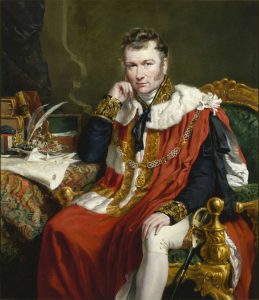
Sir George Hayter, Charles Stuart, Baron Stuart de Rothesay (1779-1845), 1830 © image: Crown Copyright
This portrait by Sir George Hayter depicts Lord Charles Stuart posing ceremoniously in his peerage robes. On his desk are diplomatic treaties and a map of Spain as a reminder of his campaign against Napoleon. Originally displayed in the family seat at Highcliffe Castle in Dorset, the portrait and its companion pieces showing Lord Stuart’s family now hang in the opulent Salon Rouge (Red living room).
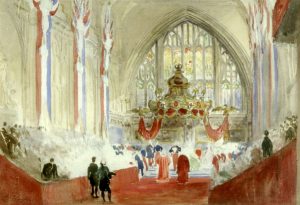
Sir George Hayter, Napoleon III’s Reception at the Guildhall, 1855 © image: Crown Copyright
Matrimonial alliances, exchanges of visits, conflicts and resolutions have shaped the long history of diplomatic relations between Britain and France. In April 1855, Napoleon III and his wife Eugénie were received by Queen Victoria and Prince Albert at Windsor. This unfinished watercolour by Sir George Hayter depicts Napoleon III’s reception at the Guildhall in London in 1855. The three-day state visit included an inauguration ceremony, a visit to Buckingham Palace and a congratulatory address followed by a sumptuous dinner at the Guildhall.
George Hayter, by now elevated to the status of Principal Painter in Ordinary to the Queen, was called upon to sketch the event. His watercolour displayed in the Stuart Guest Room of the Paris residence, vividly captures what Queen Victoria described as: ‘the very intimate alliance which now unites England and France.’
Later that year, Queen Victoria reciprocated the visit. It was the first time a British monarch had travelled to France in over 400 years. The historic occasion was celebrated with a spectacular feast at Versailles. Queen Victoria also visited the Paris Embassy where she saw the copy of her portrait painted by William Corden after Franx Xaver Winterhalter. Placed in the entrance hall of the Embassy, its solemn air draws today’s visitors into a space situated between the shadow of Princess Pauline and the light of more recent figures.
Take yourself on a virtual walk, through the sumptuous British Ambassador’s Residence in Paris below
Written by Dr Laura Popoviciu, Curator (Historical)

